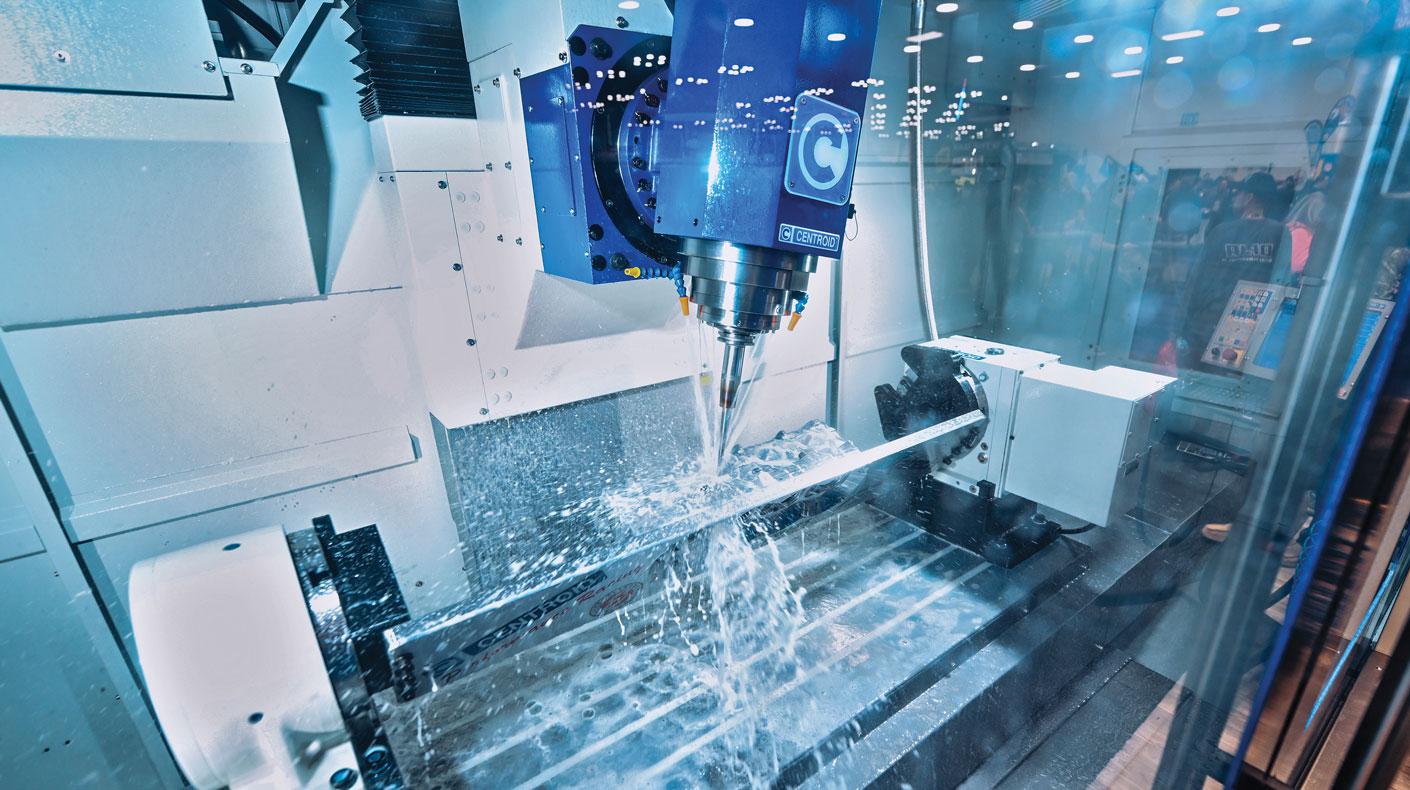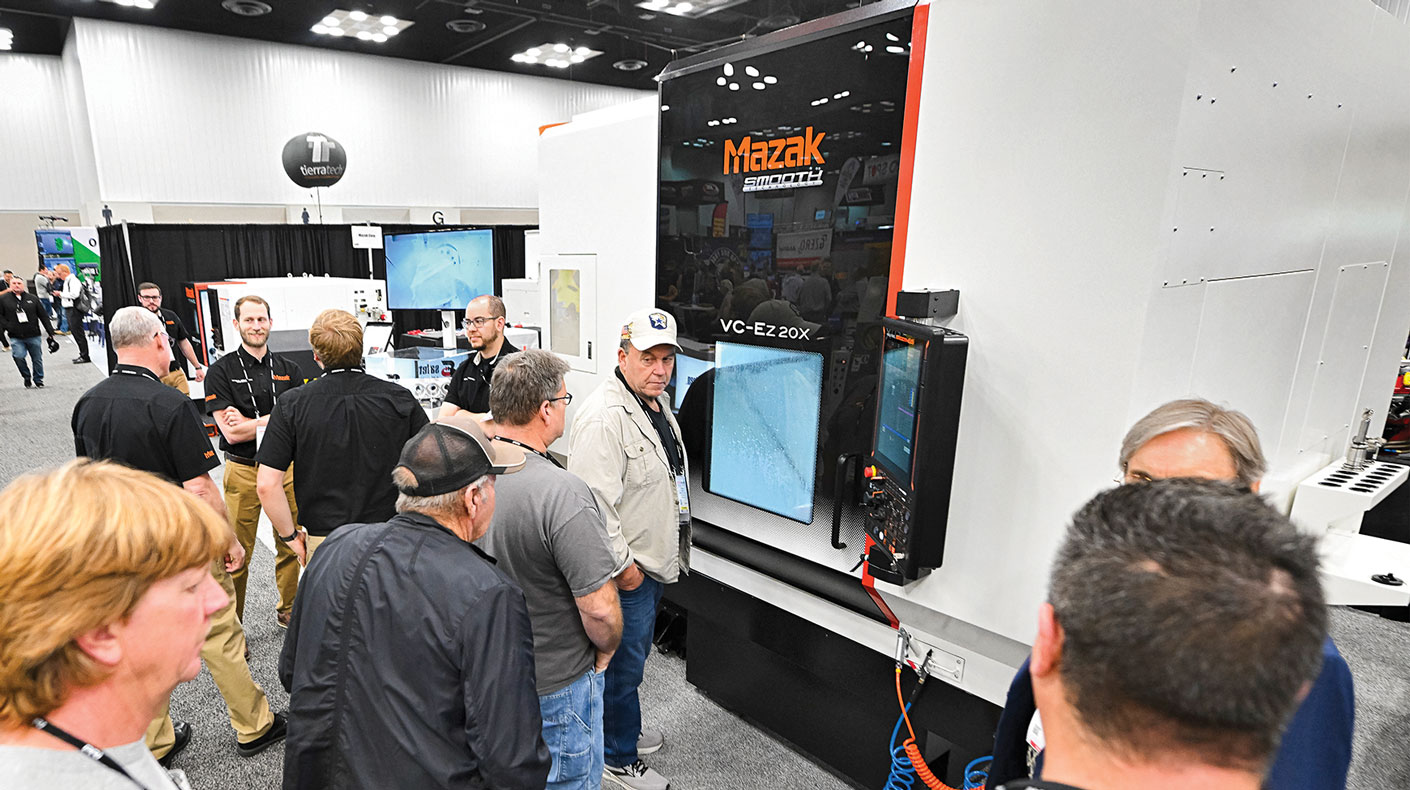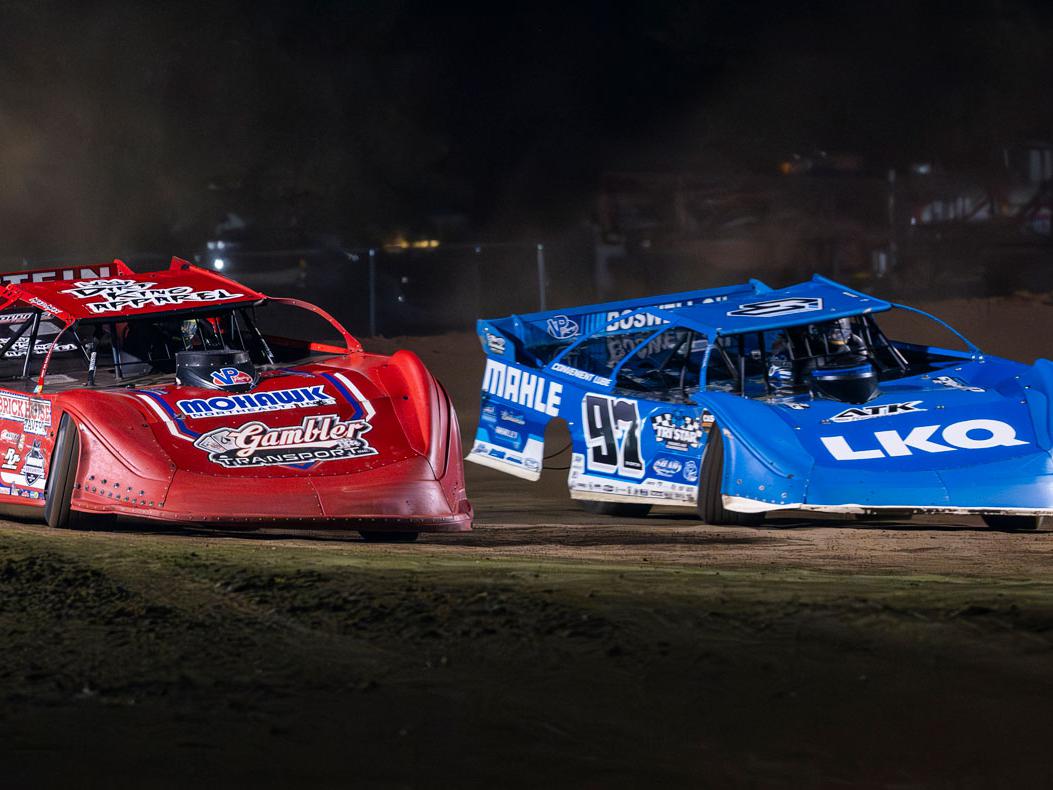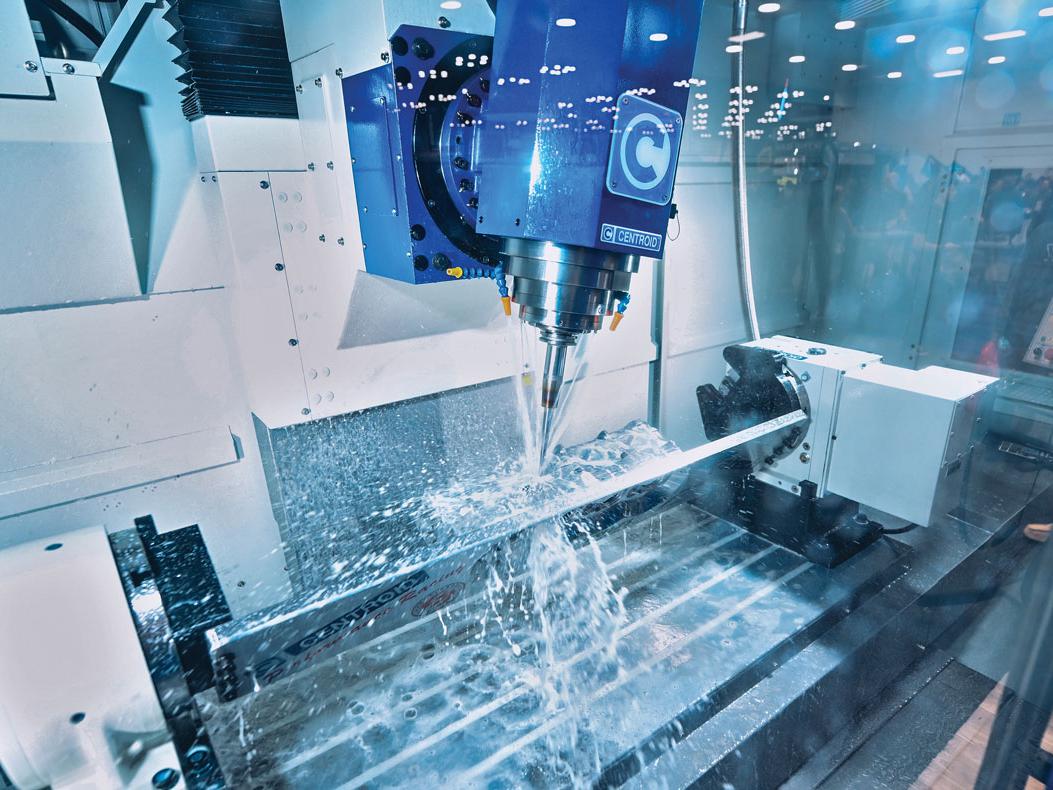CNC Refinements for Improved Performance

How modern machines are integrating automation and improving performance.
A technological revolution is underway.
Automation and artificial intelligence (AI) are rapidly changing the way people learn, work, and develop new innovations and products. The technology is already impacting nearly every industry.
Within the motorsports industry, this revolution is being felt in a variety of ways. While individual race teams explore integrating AI software for assisting with race strategy simulation or optimizing component development, parts manufacturers and builders are learning to embrace the benefits of CNC machining and increased automation to improve accuracy, efficiency, and performance.
"Operators need to be aware and open to the changes in the machining world, see how the technology fits their business model, and have a passionate desire to learn about what will help them achieve their goals," said John Cowher of Centroid, Howard, Pennsylvania. "To stay on the cutting edge, you have to always be looking at how to get to the next level to compete with other shops."
Today, much of that competition is centered around acquiring the best machines to help shops optimize their ability to produce race-winning components, whether that involves manufacturing new parts or machining engine blocks with the help of automation. However, for many small businesses within the motorsports space, making the jump—and investment—into automation can be daunting.
"A lot of race shops don't have a lot of volume, so they can't justify high-dollar machines," said Anthony Usher of MEC CNC, a Robins Machines distributor based in San Clemente, California. "They need simple machines that are easy to learn, anyone can work them, and they can do that kind of race work they need."
For these business owners, striking a balance between current investment and future efficiencies will determine whether a new machine is right for their shop.
EZ Learning Curve
Automation and CNC—computer numerical control—may sound great to some business owners, but not everyone is on board.
"A lot of the older guys struggle with CNC," said Usher. "They fear it a lot and worry if they get a machine that's too high tech, they won't be able to run it properly."
In an effort to bridge the gap, Robins Machines is branding its latest CNC machines with a new marketing phrase—EZmatic. Robins' SG 6 in 1 EZmatic seat-and-guide machine offers the ability to switch between manual or automated cycles, as well as a multi-angle seat-cutting system that can be calibrated to exact seat diameters. Robins will also unveil a new machine at the 2025 PRI Show—the RBS 1.11—a multi-purpose machine that does plato boring and surfacing for both large and small cylinder heads and blocks.
With both machines, the goal is to maximize production for operators while minimizing the learning curve.
"To operate this is super easy," said Usher. "When people buy a new machine, we have technicians who go out to train them, and it takes literally minutes. When you [use] an iPhone, you're not doing any programming, you're just working with icons. That's how we've made this system. It doesn't require any skills, and it's very intuitive. People can often teach themselves how to run these [machines]."
Developing easy-to-run software has been a major point of focus for the CNC machine market. While automation may initially seem intimidating to traditional operators, a simple interface can make a huge difference and quickly provide significant benefits to smaller shops.
"We have invested in software to make the machines very simple to operate," said David Bianchi of Rottler Manufacturing, Kent, Washington. "Most of our machines operate from the same platform, so operators can quickly go from machine to machine without hours of training. The ease of operation is important in shops because most times the operators are not trained in G-code. With Rottler automation, they don't need to be."
Training an operator to learn G-code—a combination of letters and numbers used to program CNC machines—takes both time and money. However, with today's more user-friendly software, more people in the shop are able to operate the machines with only minimal training.
According to Eric Smith of Smith Advertising International in Williamston, Michigan—a partner of MEC CNC—this can be a complete game-changer for smaller shops operating with limited personnel.

Mazak is another manufacturer that has simplified the operation of some of its machines to not only make them easier to use, but also easier to train personnel to use them. Mazak displayed its VC-Ez X vertical machine centers at the PRI Show.
"In the motorsports world, sometimes the staff gets spread thin," said Smith. "So they may have a guy who does three or four other things but has some machining knowledge. So they bring in this machine, they train him, and now he can add that to his daily routine without [many] hours or dollars invested into training him to run it. That's how this technology is changing the industry. It requires less time and investment in the person. Of course, there's investment in the machinery, but it can be run without a huge curve of training."
With less time and money required for training, shops can quickly begin to reap the rewards of today's automated machines. Additionally, this allows skilled operators to be more productive and spend less time on mundane or repetitive work.
"The skilled machinists can oversee more in regard to quality control, machining operations, and processes," said Bianchi. "In many ways, this technology has allowed us to scale these critical employees. At the same time, automation has allowed us to be faster, simpler, and better than ever before. This is a winning combination."
Time & Cost Efficiency
Success in motorsports starts with efficiency. Companies only have so many resources to produce more parts, develop better components, and help teams find advantages. If maximizing time and money is the recipe to success, automation might be the most important factor to unlocking a company's potential.
"If it doesn't have automation, it requires an operator to be at the machine all the time, operating it," said Usher. "So the cost of the operator comes into the overall cost of the investment, as well as the skill of the operator. Less computerized machines require more skill."
For example, Robins' RBS 1.11 machine offers automatic hole-to-hole boring and surface finishing. "The machine can go down and bore a whole row of cylinders unattended and automated," said Usher. "Boring cylinder blocks is a pretty simple operation, so people appreciate that they can just let it work on its own. The surfacing also has a simple programming system called multiple pass, where you can set the amount that needs to be removed and the amount per pass, and then it'll keep going over and taking incremental cuts until it'll take a final pass to give you the correct surface finish. That's a great feature, especially when you get to modifications like angle milling."
The ability to automate tasks like cylinder block boring is a great way to improve shop efficiency, as operators can work on other tasks while the machine works. Usher explained that Robins' valve seat cutter also delivers impressive time savings.
"I was talking with a gentleman who said he takes about 15 to 20 minutes per valve seat, but he's able to achieve a good result. He's very experienced, but I said to him, 'Sir, with this EZmatic seat cutting machine, it'll take you about 10 to 15 seconds per valve seat.' So these computer systems are allowing it to be more productive and more accurate in this time."
Like many companies in the space, Rottler continues integrating automation into its machines. According to Bianchi, this results in massive leaps in productivity for customers.
"Our machines are some of the most automated in the industry, and we continue this commitment," he explained. "Rottler led the charge many years ago by automating. Today, the entire Rottler machine lineup has some degree of automation, and in many cases, we have automation that will cut labor down by over 85%. We recognize this as a huge benefit for our customers. In many cases, the automatic machines are almost like having another employee."
Not only is the machine's productivity like having another employee, but with even more advanced programming being developed, these "machine employees" are finding ways to improve performance and deliver unparalleled accuracy.
Simple conversational operation and dual-panel touchscreen control are two features on CNC machines available from Comec in Masury, Ohio. Its ACF200-CNC is a CNC boring machine that combines the operations of reconditioning monoblocks, such as boring and smoothing, in one machine.
Comec offers two CNC head and block resurfacers with its RP1000 CNC and RP1400 CNC. The RP1000 CNC can detect the profile of the cylinder head through a laser sensor that scans the surface of the heads with a dedicated software, process the data collected, and automatically perform the resurfacing operations while managing the working parameters in an optimal way.
The RP1400 CNC uses a brushless motor for the automatic and precise positioning of the milling cutter plate, which is controlled by the CNC, with tested technologies such as the linear guides and recirculating-ball feed screws. The axes and the rotation speed of the milling cutter are controlled by an inverter, and the feed speed can be monitored.
New Frontiers
While many of today's machines offer automation, companies like Rottler are actively looking to AI as the next frontier of development.
"We recognize AI as a tool that will take us to the next level," said Bianchi. "While we do not currently use AI in any of the machine systems, we are reviewing ways that we can utilize AI to improve overall customer experience, get closer to customers' needs, and assess industry demand."
While AI developments may benefit the machines of tomorrow, the digital connectivity of today's CNC machines helps manufacturers work with shops to optimize machines from afar.
"We connect digitally with customers on a daily basis to provide software updates and improvements," said Bianchi. "We also use digital connectivity to review data and troubleshoot machines all over the world. This allows us to get real-time data while significantly improving response time."
Response time is not the only thing that Rottler has been able to improve. According to Bianchi, recent advancement in honing automation has led to increased horsepower for customers.

Rottler's machines "are some of the most automated in the industry, and we continue this commitment," David Bianchi said. The entire Rottler machine lineup "has some degree of automation, and in many cases, we have automation that will cut labor down by over 85%."
"Over the last three or four years, Rottler's H85AX has revolutionized honing with customers consistently reporting more horsepower. The automation not only saves operator time, but it also produces better cylinder finishes and improved bore geometry. The hone literally knows where and how much it needs to work the cylinder to produce optimal results."
Centroid has been working on integrating machine simulation into its systems to help predict bad outcomes and prevent machine breakage.
"We are working on integrating machine simulation into our systems either as part of our five-axis turnkey or option," said Cowher. "The ability to be able to simulate complex programs before they go to the machine is necessary in today's times and beyond. Everyone now wants to make high-performance parts from billet, whether it's a cylinder head, an engine block, or whatever. You can't risk machine crashes destroying tooling, materials, let alone machine breakage. This gets really expensive, really fast. Although machine simulation isn't something new, we are just now starting to offer it as we see the need for it in today's machining world."
In today's fast-paced environment with powerful technology growing by the day, manufacturers and race shops must grapple with a similar question: how to stay ahead without crossing a line.
"The biggest challenge that we face is determining how to embrace this technology without introducing risk," said Bianchi. "One benefit that Rottler has is that we are a cradle-to-the-grave manufacturer. From engineering to finished product, we have the resources to do it all. Because of this, much testing can be done in-house."
In addition to Rottler's in-house capabilities, its team also collaborates with motorsports clients and engine builders who "like to see new technologies and are very receptive to working together to introduce new technologies.
"Motorsports clients are constantly asking for more automation and looking for ways to have a competitive edge," Bianchi added. "We are investing heavily in young and talented engineers who are looking to bring creative solutions to race engine builders."
It's no secret that an arms race is underway in the tech world, as the power of AI grows by the day. However, the same is true in our industry, as leading motorsports manufacturers race to leverage the power of AI and automation in pursuit of more power, more speed, and more trophies.
To better understand how automation and AI are enhancing machines' capabilities, there's no better place than Machinery Row at the 2025 PRI Show in Indy. With most major companies in attendance, you'll have the opportunity to speak with leading engineers, see demonstrations of cutting-edge machines in action, and learn more about where the new AI frontier will lead.
To read more like this for free, sign up for a digital subscription to PRI Magazine on Zinio here.
Once you download the Zinio mobile app or are logged into Zinio on a desktop browser, you will gain immediate access to more than a year's worth of content, including "CNC Refinements" here and more shop machinery coverage in the August 2025 issue here.
Sources
Centroid
centroidcnc.com
Comec
comecus.com
MEC CNC
meccnc.com
Robins Machines
robinsmachines.com
Rottler Manufacturing
rottlermfg.com
Smith Advertising International
smithadvertisingintl.com
 MEMBERSHIP LOGIN
MEMBERSHIP LOGIN JOIN PRI
JOIN PRI


